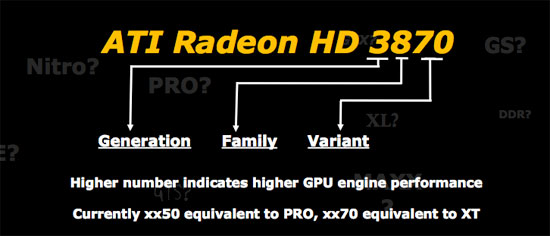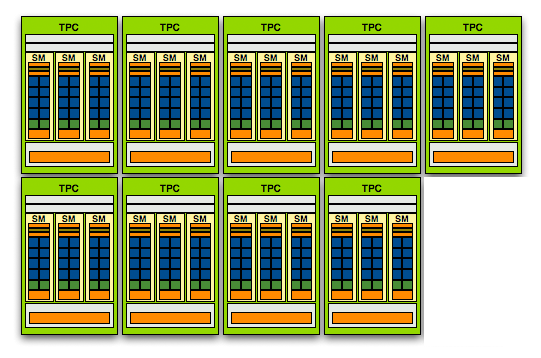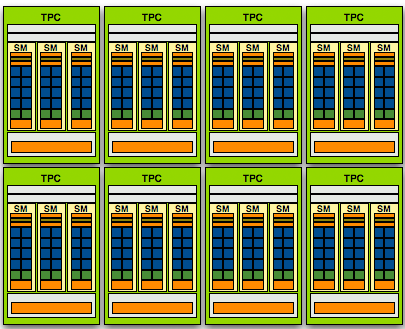NVIDIA GeForce GTX 260 Core 216: Competition for the 4870
by Anand Lal Shimpi & Derek Wilson on September 16, 2008 12:00 AM EST- Posted in
- GPUs
Nearly a year ago I wrote about something I called "sensible naming" with respect to GPUs. It was at the time of the Radeon HD 3800 series launch where AMD unveiled a much cleaner, simpler way of naming its cards. Gone were the suffixes (for the most part) and instead what we were left with was this:

A family name, Radeon HD, followed by a four digit number. With the exception of the X2s, AMD has stuck to its naming system without fault. In fact, AMD has done such a good job with keeping the names clean that things are the way they should be: the internal codenames are more difficult to remember than the actual names of the cards (e.g. RV770 vs. Radeon HD 4870).
NVIDIA however, just hasn't gotten the hint. The GT200 launch gave us two simply named cards: the GeForce GTX 280 and GTX 260, but it didn't take long for NVIDIA to confuse the marketplace with the launch of the GeForce 9800 GTX+. I hoped that the naming silliness was limited to the older GeForce 9 GPUs, but today it extended into the GTX lineup.
It's called the GeForce GTX 260 Core 216.

Holy nomenclature Batman
The GeForce GTX 260 Core 216's name is actually quite descriptive, albeit absurdly long. The GeForce GTX 260 part we already know from the GT200 launch, the Core 216 suffix just indicates that the GPU has 216 "cores" (also playing on Intel's new Core i7 naming for Nehalem, due out later this year). Why NVIDIA didn't just call it a GeForce GTX 265 or 270 is beyond me. To make matters worse, we'll see companies adding their own suffixes to the already extended name. For example, EVGA sent us their Core 216 called the EVGA GeForce GTX 260 Core 216 Superclocked Edition. Perhaps it's some conspiracy to increase the salary of writers who get paid by the word.
| GTX 280 | GTX 260 Core 216 | GTX 260 | 9800 GTX+ | 9800 GT | |
| Stream Processors | 240 | 216 | 192 | 128 | 112 |
| Texture Address / Filtering | 80 / 80 | 72/72 | 64 / 64 | 64 / 64 | 56 / 56 |
| ROPs | 32 | 28 | 28 | 16 | 16 |
| Core Clock | 602MHz | 576MHz | 576MHz | 738MHz | 600MHz |
| Shader Clock | 1296MHz | 1242MHz | 1242MHz | 1836MHz | 1500MHz |
| Memory Clock | 1107MHz | 999MHz | 999MHz | 1100MHz | 900MHz |
| Memory Bus Width | 512-bit | 448-bit | 448-bit | 256-bit | 256-bit |
| Frame Buffer | 1GB | 896MB | 896MB | 512MB | 512MB |
| Transistor Count | 1.4B | 1.4B | 1.4B | 754M | 754M |
| Manufacturing Process | TSMC 65nm | TSMC 65nm | TSMC 65nm | TSMC 55nm | TSMC 55nm |
| Price Point | $420 - $500 | $279 | $250 - $300 | $200 | $130 - $170 |
If you remember the diagram below from our GT200 review you'll see that a GeForce GTX 280 has ten clusters of 24 stream processors (the little blue blocks), for a total of 240 SPs or "cores". The GeForce GTX 260 has eight of those clusters (called Texture/Processor Clusters or TPCs), bringing its total up to 192 SPs. The Core 216, as you can guess, has nine clusters or 216 SPs. NVIDIA just enabled another TPC on the Core 216 (or alternatively, disabled a TPC on a GTX 280).

The GeForce GTX 280, 10 TPCs, 240 SPs

The GeForce GTX 260 Core 216, 9 TPCs, 216 SPs

The GeForce GTX 260, 8 TPCs, 192 SPs
The extra TPC also gives the Core 216 another 8 texture address and filtering units, but the rest of the chip's makeup remains the same, even down to the clock speeds. The Core 216 runs its core, shader and memory clocks at the same frequencies as the vanilla GTX 260.
Priced at $279, the Core 216 is a direct competitor to AMD's Radeon HD 4870 - selling at a similar price. The GTX 260 will continue to exist although selling at a cheaper price point and naturally with more processing power, the GTX 280 remains unaffected.










65 Comments
View All Comments
Mr Roboto - Tuesday, September 16, 2008 - link
No, no, that's not confusing enough. The GTX260 Core 216 fits perfectly with the 8600GT\GTS, 8800GTS 640\512\320, 9600GT\GSO and the 9800GTX+. Can't wait to hear the naming scheme for the 55nm GTX280's.Boushh - Wednesday, September 17, 2008 - link
How about the GTX260 55nm Core 216 :)yyrkoon - Thursday, September 18, 2008 - link
How about . . . " a failed GTX 280 " core ; )SiliconDoc - Sunday, October 5, 2008 - link
Gosh, sorry I have to vent here. lol -I know you were being a wise guy - so take it with a grain of salt.
ou don't really believe that excuse, do you ? I mean the corpo planners have you eating their goat cheese like a baby.
" Oh lookie here, the exact parts we need failed , failed again, wow, just a shaders region and one mem spew bank, man we get lucky a lot ! Ok, just cut that line on the corecap, and stamp it a 260 !"
.
( I mean really...).
Yes, of course they can grade bin somethnig like an E8400 / E3110 for voltage hence decency, but I've never believed they just whack out a 280 to make it a 260, or the other endless derivations of the basic deal...
They control multipliers IN MANUFACTURE, fine. If they stamp on a different name, fine.
But having this " lucky failed chip " taken to every extreme - I simply don't believe it.
280.260 "same core" - yeah, fine, they PLAN on the 260 core reductions, then produce them as such.
Same as with all their other crap...
We've found MANY times before - their locked chips - when unlocked did just as well as the higher versions, sometimes even better.
Anyway.
crimson117 - Tuesday, September 16, 2008 - link
or GTX 280 GSOsilversound - Tuesday, September 16, 2008 - link
Anandtech just keep getting better, tomshardware just plain sucks & bias now.Any reviews on the new 4850X2?
Anand Lal Shimpi - Tuesday, September 16, 2008 - link
We're still waiting on review samples of the 4850X2 as well as the new 1GB RV770 cards. As soon as we get some in for review we'll get on them :)-A
mmntech - Tuesday, September 16, 2008 - link
When has Tom's ever not been biased? They used to be vary pro-Intel, pro-ATI if I remember correctly.I'm impressed with nVidia's numbers since I had figured they had abandoned the mid-range market again when the release of the GTX series, which were double the price of what ATI was offering. Good frame rates, fair price, and lower power consumption than the HD 4870. Not a bad buy. I wish I had kept with nVidia rather than getting an HD3850 earlier this year. While it's a good card, it has driver trouble with older games like KotOR (low frame rates, missing effects) and ATI's Linux compatibility sucks.
Gannon - Wednesday, September 17, 2008 - link
Toms was ok back in the day, and sometimes for CPU/VGA charts, but for most everything else they were just not very good. They are a dumbed down version of anandtech for the masses.JarredWalton - Tuesday, September 16, 2008 - link
I only wish I could run SLI on an X38 chipset (without the silly nForce 100/200 bridge). Until that happens, I'll use ATI hardware for this generation. Hopefully with the Nehalem stuff, I can pick up an X58 board with support for both GPU platforms. Though I have to say, my dual 3870 cards are starting to look awfully sad. :(